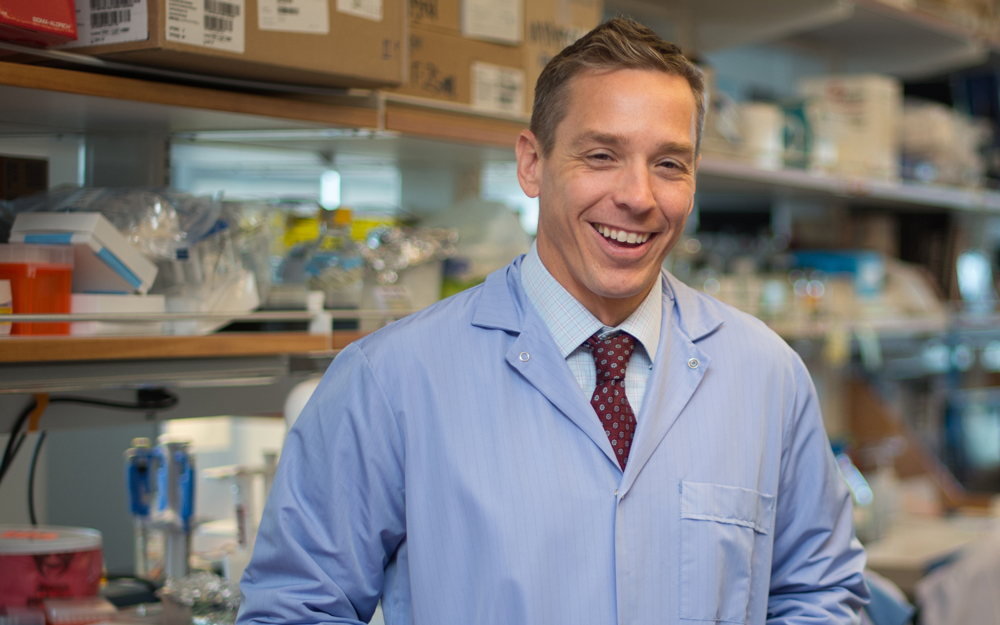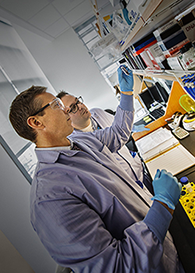Cedars-Sinai Blog
For Dr. Robert Baloh, His Work with ALS Isn't Just About Finding a Cure
May 07, 2017 Cedars-Sinai Staff

Dr. Robert Baloh, Director, Neuromuscular Medicine, ALS Program
Even patients who can't be cured today still need doctors.
That's the simple explanation Dr. Robert Baloh provides for what drew him to working with patients who have neuromuscular diseases like amyotrophic lateral sclerosis, or ALS. The scientific challenge and growing research opportunities in the field are intriguing—but it's the difference he can make in the lives of people he treats right now that matters most and inspires him to keep pushing scientific frontiers.
"I entered this field for the chance to make an impact," he says. "Not just in research. From a caregiving perspective, I learned during residency that I could help patients, even without a pill to make everything better. I could give them information and care for them. I could still be their doctor."
When he came to Cedars-Sinai 5 years ago, he had 30 patients. Now, the ALS program serves 260 patients who can participate in genetic studies, stem cell research, and the clinical trials that have helped make the program one of the nation's best.
"We want patients spending time thinking about and doing things that aren't related to their disease at all."
Focusing on Now
Talk about ALS, often referred to as Lou Gehrig's disease, long enough, and the subject turns to time: How long are people expected to live?
In Dr. Baloh's office, the focus is on the only time any of us know we have: the present.
The many experts he's assembled to help ALS patients—neurologists, nurses, fellows, physical therapists, an occupational therapist, speech pathologists, registered dietitians, pulmonologists, neuropsychologists, research coordinators—are available to see patients the same day to minimize the amount of time patients spend waiting in doctor's offices.
"We want patients spending time thinking about and doing things that aren't related to their disease at all," Dr. Baloh says.
In his residency, he met many patients and families dealing with severe diseases and suffering. He wanted to do something about that suffering, so he built a program that's about providing the best care for patients today by individualizing treatment plans and managing immediate needs.
"We work with patients to develop a proactive strategy for their lives today."
"We want our patients to enjoy coming to the clinic and see it as a positive place, a place where we can help get them involved in research or a place where we can help them overcome challenges they're faced with."
There isn't time to dwell on or speculate about the past. It's not unusual for newly diagnosed patients to wonder if an old injury or some environmental factor caused their disease—something they worry they should have or could have prevented. Dr. Baloh assures them that ALS is not their fault. Though it seems some athletes and military veterans are at a slightly higher risk of developing the disease, no one knows why.
"It's human nature to ask, 'Why did this happen to me?'"Dr. Baloh says. "Though chances of getting the disease increase slightly, not every football player or veteran will develop ALS. Instead of attaching guilt to actions in the past, we work with patients to develop a proactive strategy for their lives today."
Discussions about the future often revolve around the scientific search for better treatments for ALS, offering patients an opportunity to participate in research that might help the next person diagnosed. Hearing about progress in treating ALS offers some patients hope. For others, participating in research is meaningful.
Read about Lance McCullah's journey: Tackling Life After ALS
Looking to the Future
Dr. Baloh is excited about an ALS trial approved by the Food and Drug Administration in fall 2016 to test a combination of stem cell and gene therapy developed with the intention of stalling the disease's progress and preserving leg mobility in patients.
"Any time you're trying to treat an incurable disease, it is a long shot, but we believe the rationale behind our new approach is strong," said Clive Svendsen, PhD, director of the Cedars-Sinai Board of Governors Regenerative Medicine Institute, who has spent a dozen years developing the new approach.
The hope is the stem cells will generate the needed glial support cells, which in turn will keep the motor neurons alive.

Dr. Baloh in lab
Patients with ALS become paralyzed as the disease kills motor neurons—nerve cells that deliver the signal for muscles to move. Part of the reason these neurons die is they lose the support of their neighbors, glial cells—cells tasked with making an important protein, known as glial cell line derived neurotrophic factor, or GDNF.
The new therapy involves engineering stem cells to produce the protein, and replicating them until billions are formed. The protein-enhanced cells will then be implanted in patients. The hope is the stem cells will generate the needed glial support cells, which in turn will keep the motor neurons alive.
Dr. Baloh's clinical team will coordinate the trial developed by Svendsen and his team, and neurosurgeon Dr. Patrick Johnson will perform the procedure to deliver the cells to patients.
The trial could begin by the end of the year, but results—and what they mean for those with ALS—are further in the future. In the meantime, Dr. Baloh will keep focusing on the present and searching for answers. For him, being a doctor means doing everything he can.


